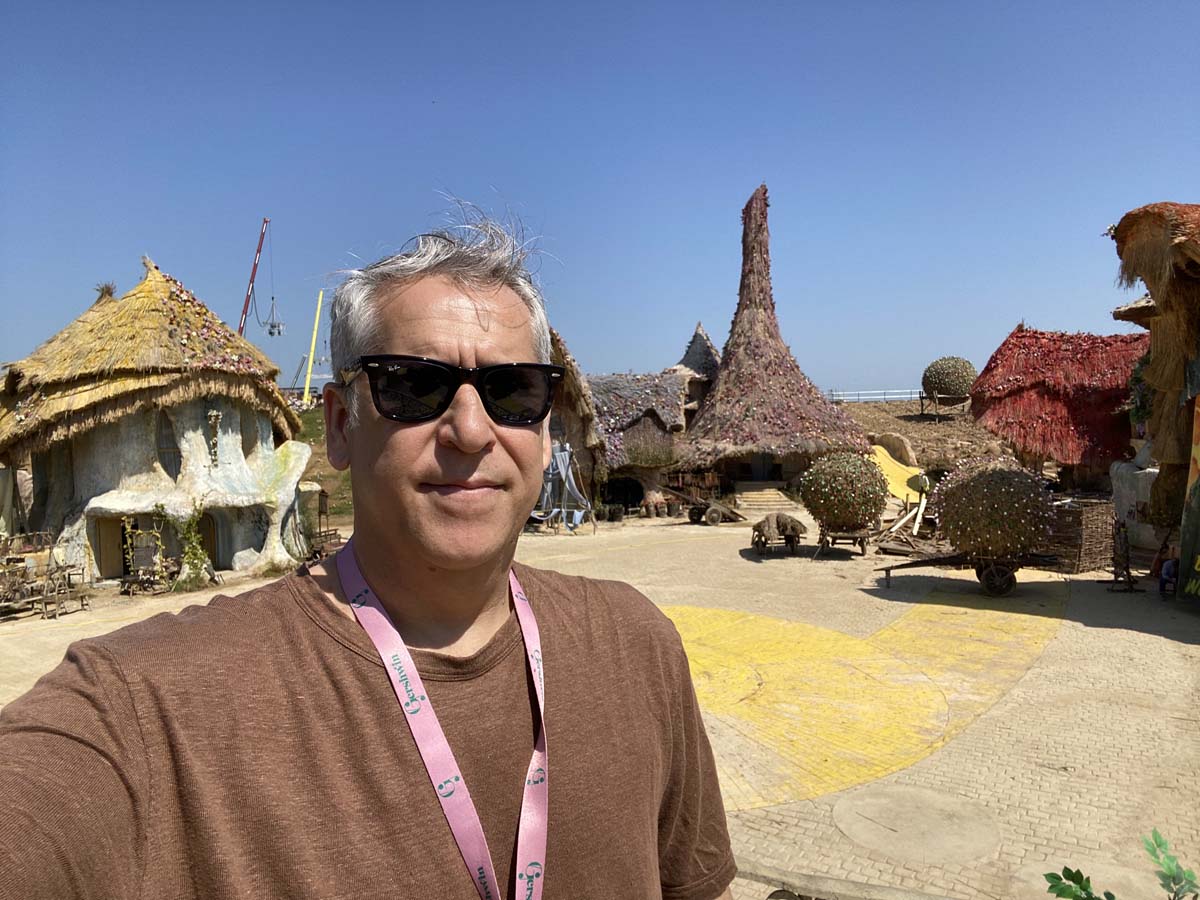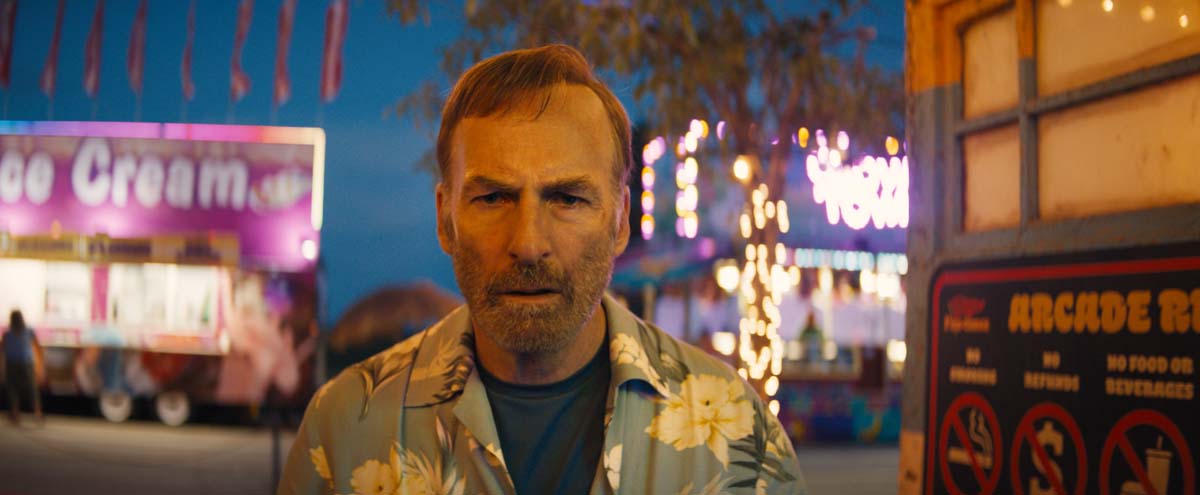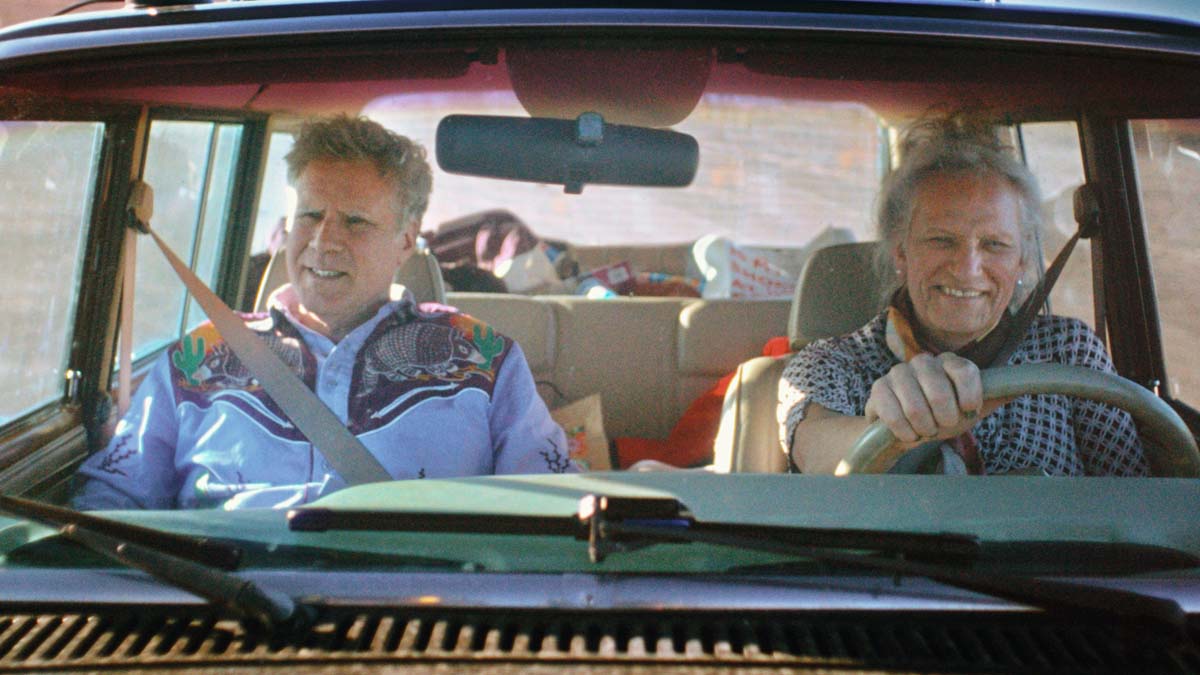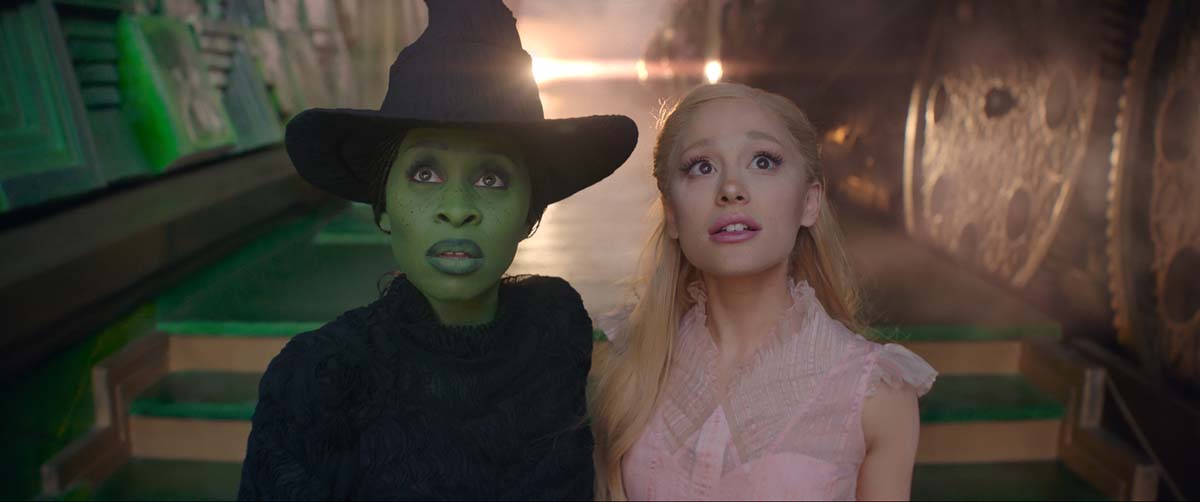Wicked for Good
This interview discusses the value of story cards on a wall, the complexities of editing vocals recorded live during filming, and the implications of this film’s darker tone and operatic power.
Today on Art of the Cut, we speak with multi-Oscar-nominated editor, Myron Kerstein, ACE, about editing Jon Chu’s Wicked for Good.
Chu and Kerstein last worked together - of course - on Wicked. And before that on tick, tick… BOOM. Before THAT they collaborated on In the Heights. And before THAT on Crazy Rich Asians - and we’ve talked about ALL of those films here on Art of the Cut.
Kerstein’s previous work as an editor includes the feature films Going in Style, Garden State and Glee: The 3D Concert Movie. He’s also expanded his talents to the director’s chair, but that’s a topic for another interview.
Myron. I just got out of Wicked for Good moments ago, and I’m still buzzing from the spectacle and the emotion. Congratulations on a fantastic project.
Thank you so much.
The last time we spoke for the previous Wicked movie, you were already hard at work on this one. Did you stick with your same working method - which you described as not doing string outs but creating a spreadsheet of notes as you watched dailies?
Yeah, it was exactly the same way. I just felt like I had to experience the dailies in the same way - where I was actually cutting both films at the same time.
I also brought in Tatiana Riegel, five months into the shoot to help with the assembly, because I was getting pretty overwhelmed by what ended up being 250 hours of footage between the two movies.
To answer your question, I feel like I had to stick to my process, which is: I’m going to watch all the dailies and make notes in a spreadsheet, and if something makes me cry or laugh, or gives me goosebumps, I’m going to make note of it, I’m just going to take this sacred moment of watching dailies in a movie theater and see the Yellow Brick Road come to life, or see “For Good” for the first time.
I get to be the first audience member and feel it and not rush the process. Sometimes I can cut a scene in the day, and sometimes it’ll take me three weeks to cut a scene. It’s how I’m responding to something.
And of course, if they need a scene cut together in order to pick up more footage or different angles, then I can do that in a heartbeat.
But for me, it’s about trying to find the scene even in the assembly stage, but that has to begin with watching the dailies and feeling them and not rushing the process - seeing the forest from the trees - seeing the big picture as far as how these characters are working and how I’m responding to everything emotionally.
You mentioned that you were watching dailies in a theater. Were you really doing that?
Yeah, I built a small screening room in Sky Studios - despite my line producer’s best efforts. I tried to create a place where I could watch on the big screen, so we built a fairly large-sized screen, set up a great projector in there, then invited the keys (department heads) when they wanted to come in there to watch makeup tests or dailies.
They were invited to use it any day they wanted to watch something. I was there or my crew was there to screen for them.
Then around 10 or 11 every morning I would sit there and watch dailies for two, three, four or five hours, depending on how much we shot the day before.
It was really, really helpful to see on a bigger screen because sometimes when you’re watching things on small screens - even if you have a big monitor - that can make your choices a certain way, so I just wanted to watch on the biggest screen possible and sit there and react to the footage.

Editor Myron Kerstein, ACE
There were complaints about me doing that – worrying about if that was the right way to spend money - but I felt passionately that this was a big film and I needed to experience it and understand what I was dealing with every day.
Then when the heads of the studio came and they wanted to watch some dailies, that’s not a bad thing to have around, you know? To sit show them on a big screen, so it worked in a lot of different ways politically as well. it was for the benefit of the movie.
Also when we were showing sizzle reels halfway through the shoot when everyone was completely exhausted four months in and they’re saying, “How are we going to make it another four months?”
Then I could show them a sizzle reel on a nice big screen, and they could see all their work and get really excited again, so it actually worked in a number of different ways as a real way to get people excited, but for me, selfishly, I knew I was going to make a better film if I could sit there and let this wash over me in a movie theater.
Tell us a little bit about the schedule that you were on. The last time we spoke, you mentioned that both films were shot simultaneously and partly edited simultaneously.
[Director] Jon [Chu] wanted to watch both films at the end of production. He gave me 15 weeks to show him both movies. Then he told me, “Let’s show the studio both films.” I said, “Oh my God! We’re going to get killed by the studio!” But we both trusted that these cuts were good enough to show the studio the big picture, and also that for us to understand the big picture of the complete story arc.
That was a team effort. I had Tatiana to help with that. Plus my music editors did temp music for two movies, VFX put as many temp effects as they could put in even at an assembly stage.
The sound crew wasn’t on yet, so my assistant editors, led by Lara Khachooni (1st AE), Ed Marsh (VFX editor), Jack Dolman (lead music editor), and Catherine Wilson (music editor).
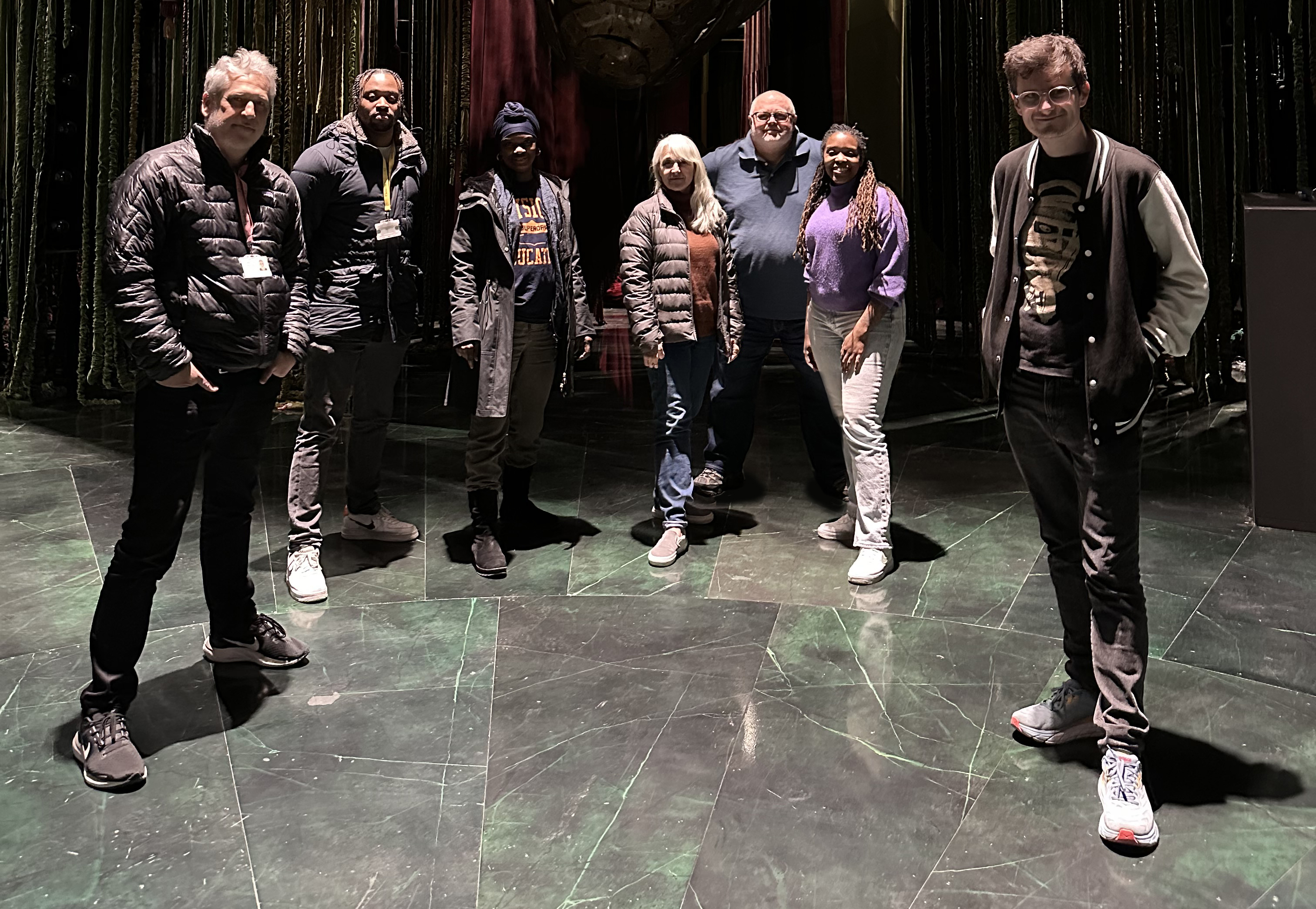
Wicked for Good post team on set.
Of course, I was mixing in the Avid so it was very intense, but it was really beneficial, because the studio trusted us and left us alone to make the first movie, then we put the second film to sleep while we worked on the first movie. We didn’t actually reopen the second movie until January of this year.
Then we had the benefit of seeing how people reacted to the first film, and we learned from that experience. Then we could start to trust what the second film was - which was a different tone - more melodramatic and more operatic and leaned into what this second film was going be about.
Tell me about the the value of putting that second film to bed for a little bit, then re-experiencing it after a little bit of a break. How did that help the process?
First of all, how many times have we ever wanted to put something away for a few weeks, then come back to it? To have a whole year to put this away and have some real distance from it was really beneficial.
Just from a practical standpoint, we just didn’t have the resources. We were using probably all the VFX vendors and artists in the world just to get the first film to work! So, just from that standpoint, we didn’t have the resources - or to be honest - the bandwidth.
When you have something the size and scale of Wicked, it’s nearly impossible, so to put it away: to concentrate on one film and know that we have to sell this relationship, and if they believe in this relationship and they want more, then that’s all we have to worry about for the first movie.
Then we can come back to the second film and have a clear perspective about it.
It’s a marathon for three years, so just pacing ourselves and the scenes we’re cutting, then coming back to something with all that time and thinking. “OK, now what is this film? What are we looking at here?”
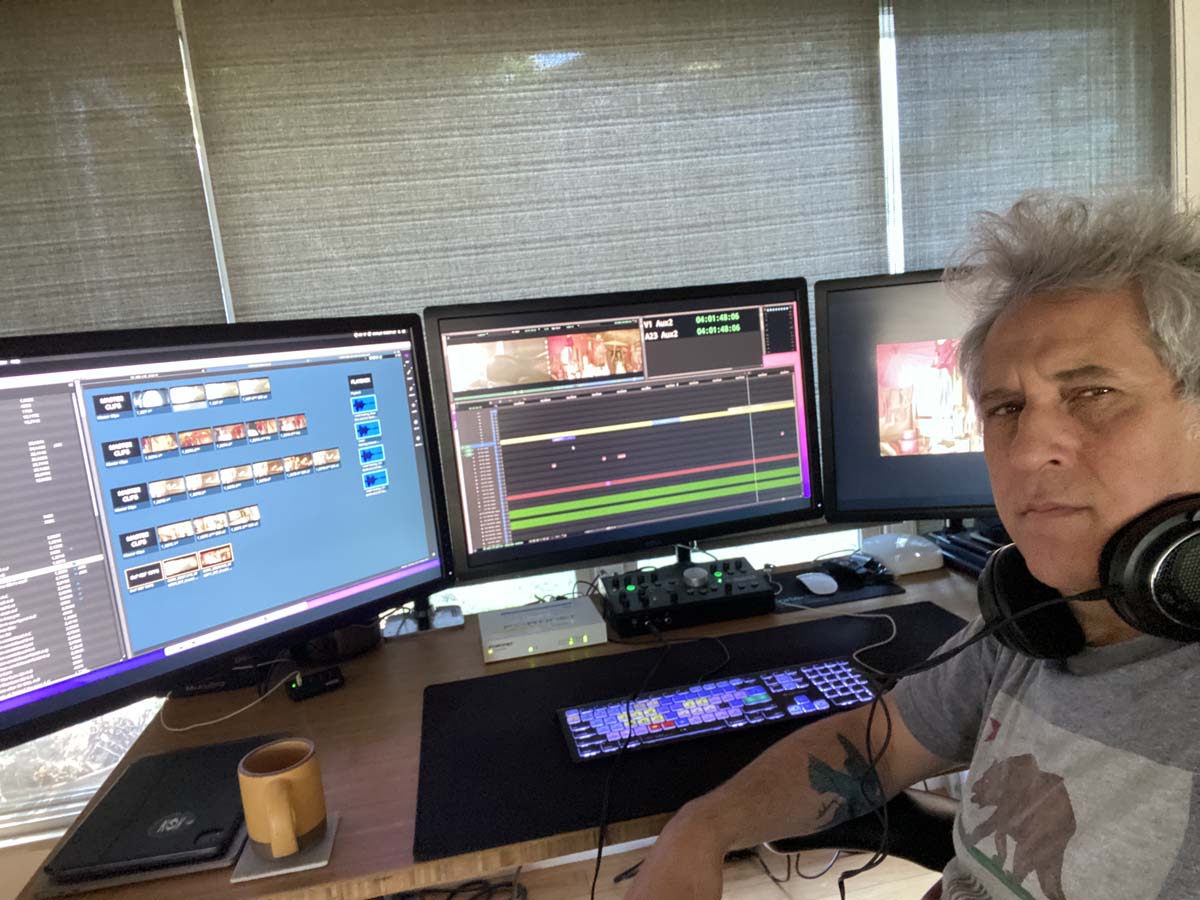
So many editors that I’ve talked to - either because of Covid or sometimes an injury to an actor – when they got a couple of months to sit and really spend time, that’s something that everybody appreciates and finds value in that break.
100%. When we did the first film, we had the actors strike and we had some time as far as shooting “Defying Gravity.”
We were assembling for a little while, then we came back to do it and there were some parts of the second film where we had that as well that we could go back and finish principal photography because of the actor strike.
So you take these little blessings in a way to just really look at and really examine these scenes of these characters in a different way.
Is the different tone something that you discussed with Jon? And how does more operatic, slightly darker tone affect your editing choices?
The first film had these moments - like the Throne Room for example - where all this confrontation happens that I felt was very melodramatic, and it’s all about the looks and the tension.
And then there are moments in the Ozdust Ballroom where there’s a lot of silence and we stretched out the emotion with the scene to make the relationship feel earned.
In some ways, I think the second film was almost all of that. I was really leaning into the idea of: if we have the Star Wars: Empire Strikes Back cliffhanger ending, then this is Return of the Jedi. I wanted to really lean into that.
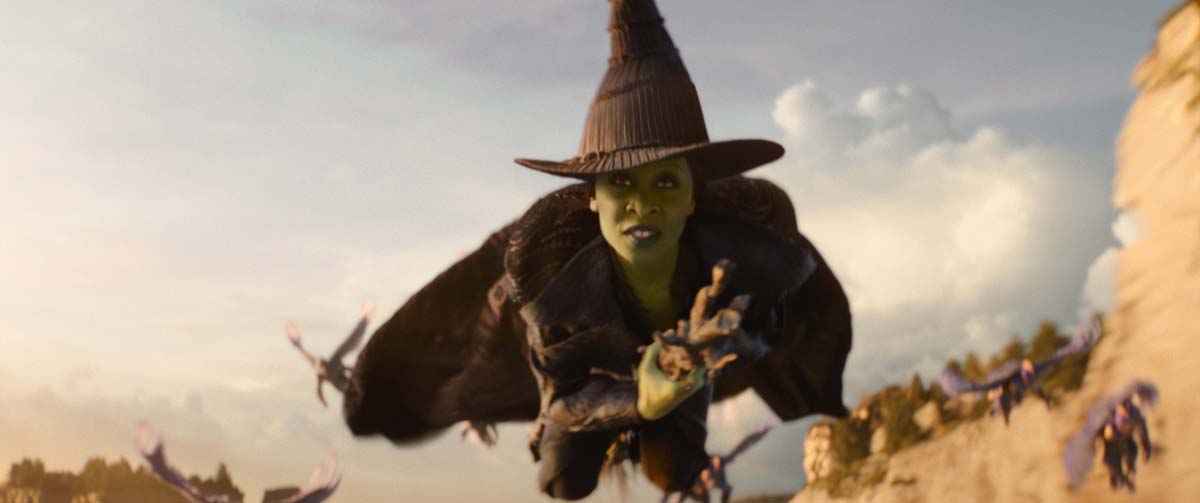
We don’t need to have the light. It doesn’t have to be whimsical. It could be serious business with these characters, and that if we yearn for these characters to be together, it’s because we had done so much work in the first film to make us want them to be together.
But here we could say, “Okay, they’re going to be apart, but we’re going to still yearn for one or the other to see them again.” So I did a lot of stretching with the pacing in this film, and I did a lot of restructuring to sort of lean into the melodrama.
But I think at the end of the day, Jon and I knew that this was going to be a much different film than the first film, and that we couldn’t be afraid of that.
As much as I wanted to please and make people laugh and have incredible dance numbers, this was not going to be that movie. I just had to embrace what the DNA of the thing was.
Let’s jump to the editing of a specific scene. One I was really interested in was the opening Elphaba attack on the Yellow Brick Road. That was a real action thriller moment.
The opening of the movie - the first 15 minutes of the movie - was quite a challenge because we had to drop into this apocalyptic world.
We had to understand that the yellow brick road was being built on the backs of these animals, and the last time we saw Elphaba, she was truly the superhero, and now we’re going to drop back into this film not knowing where we were going.
We used to have another scene that came before the scene that currently starts the movie, which was building the bricks of the yellow brick road by the munchkins.
It was a bit of a misdirect and it was a lovely moment, but we just wondered, “What is this about?” This is about her mission, so let’s drop her in.
But let’s also hide her like Batman. Let’s build in this moment because want to see her face for the first time. So how do we give the audience what they want, but also hold back a bit?
So when she finally touches down on the yellow brick road and you see her for the first time, there is a big cheer. We know that she’s looking badass, and we think that she’s going to be able to save us. Then off to the races.
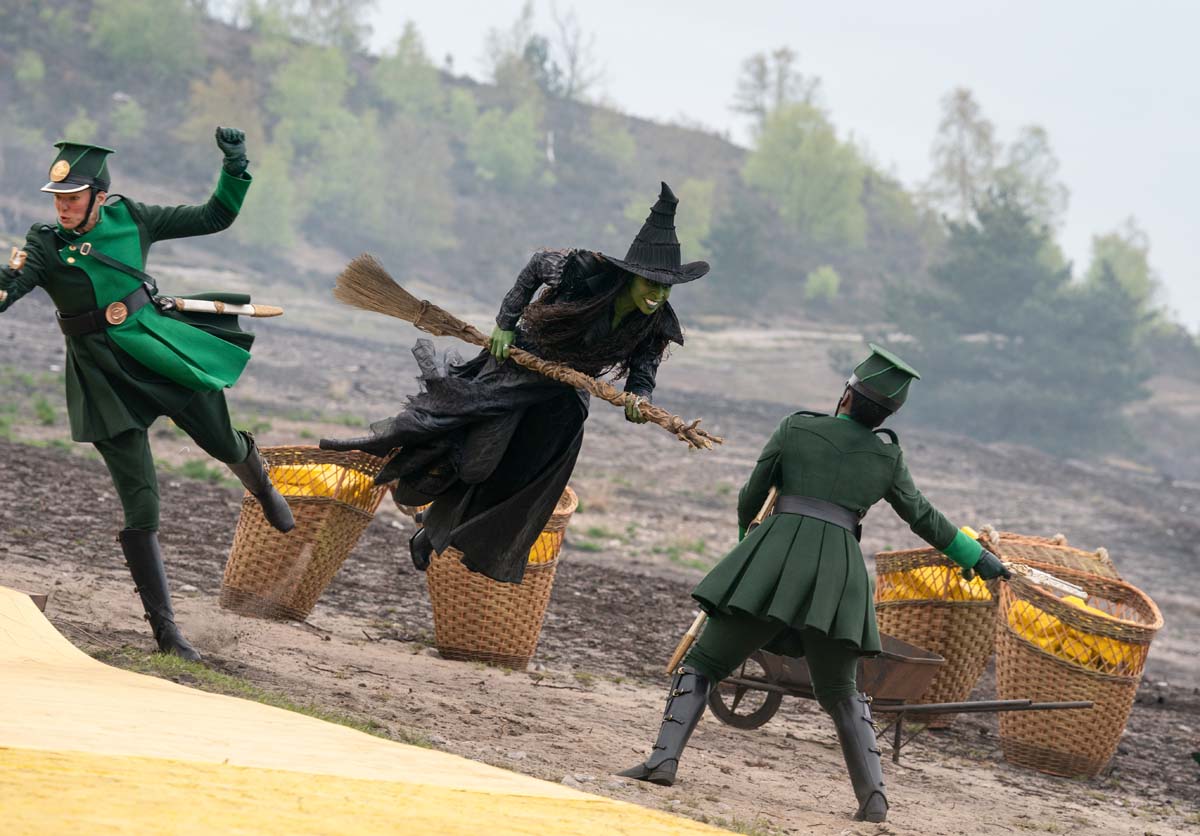
We knew that if we could drop into Oz and our world with confidence in that way, that then we could spend the next 10 or 15 minutes building up the sort of propaganda – showing where Glinda and Fiyero were - then have this musical number feel earned.
We had so many different versions where we had flashback scenes…. I had started the beginning, the movie where Elphaba was jumping off the towers in a recap of “Defying Gravity.” We were just trying every sort of version. But no. It’s about Elphaba and her mission and how are we going to deliver on that?
And that was important to start the movie that way. That’s why all that other stuff fell away.
Absolutely. And we had tried many versions. We had screened many versions for audiences and they said, “No, no, no. We don’t need any of that. As much as that’s great and cool and fun to be reminded.
We just need to know maybe how many years have passed.” That’s when we came up with this voiceover propaganda speech from Madame Morrible, which has a bit of a Haunted Mansion feel to it, which I really love.
It was just trying to build in what the tone would be and dropping in right away to show that Oz has changed over the last couple of years and now who’s going to save it?
The voiceover starts under the opening logos. That’s pretty unusual.
Yeah. As soon as we did it, that logo had a new context to it. We just love the feel of it. We knew that we could establish this tone right away. We didn’t want to waste any real estate on calibrating the audience to how the new film was going to feel tonally.
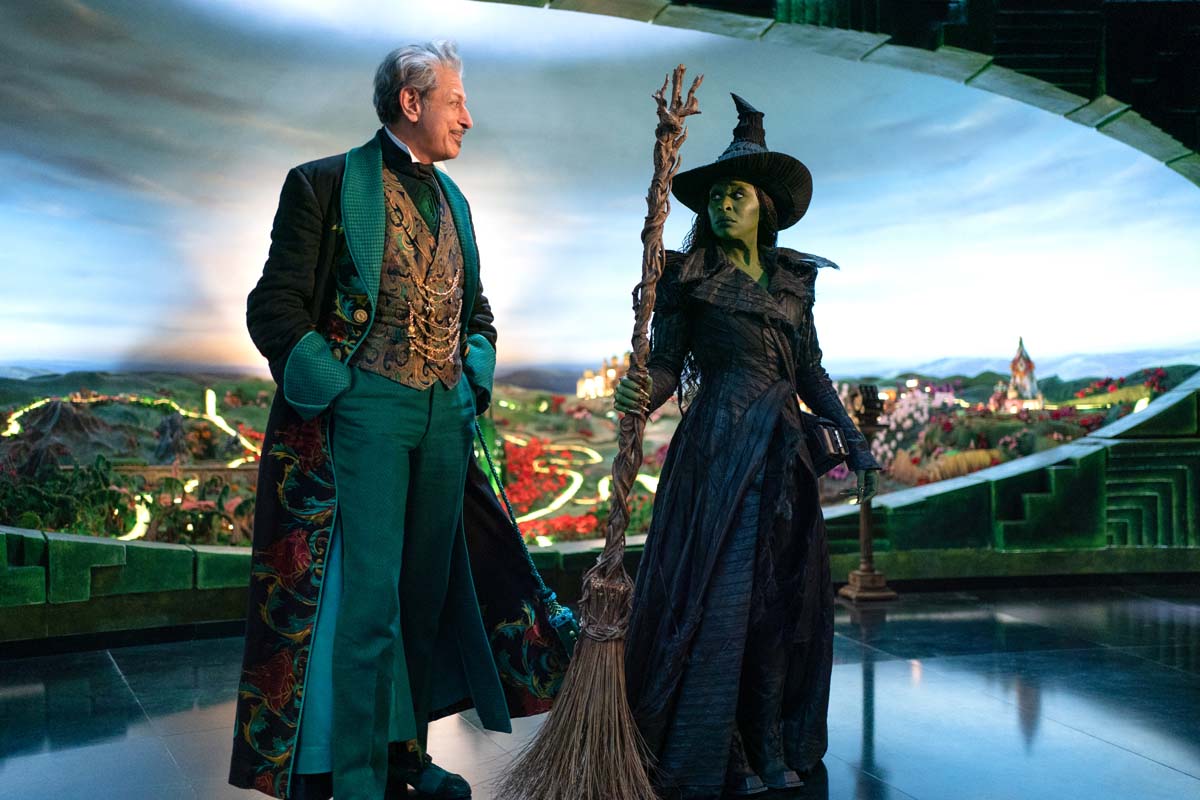
You mentioned that you changed structure to be able to enhance the drama. Can you explain what you did?
Yes. For example, the Nessa/Boq scenes actually came much earlier in the plotline, and we just felt that was a little too early to drop that. So we thought, “Okay, if we establish Glinda and Elphaba and where they are in their journey, we can have a little bit of delight and a little, “Thank Goodness” and some action scenes.
Then we can drop into the more meaty, melodramatic moments like the Boq and Nessa scenes, then feel the weight of two characters who were in a pretty good place when we left them last… and they are miserable. We had to use that restructuring strategically.
Those scenes were everywhere. We tried them in every different configuration, trying to make them work. Two versions were intercutting those scenes with “Thank Goodness.” We were making sure that we had experimented with every version that we could.
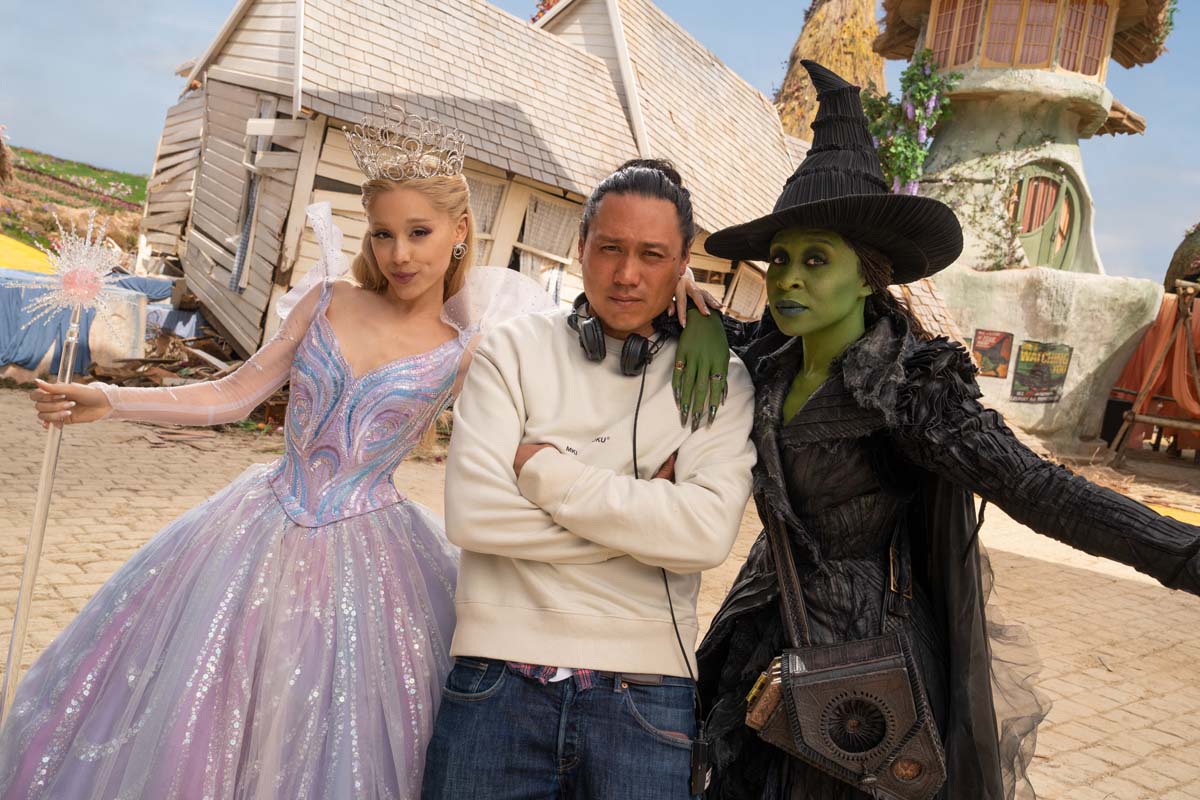
Director Jon Chu with his stars
I don’t want people to think this is a really dark movie. There is a lot of lightness and a lot of fun, and Glinda being Glinda. Was that lightness something that you were trying to spread out and keep alive?
100%. There is a scene with the younger Glinda scene at her birthday party. That was a scene that was scripted but had been never shot, so we came back and picked up that scene because we just thought having a little backstory that has some delight to it and a little fun - a little whimsical feel to it - would help, tonally.
And there are certain jokes throughout that we could put in or take out to lend itself to just a little spark of delight. Getting to “Wonderful” is an example. Getting to Jeff Goldblum is like a secret weapon.
Just when you think things are so dark – watching Boq transform into the Tin Man and that we’re just it feels full on melodrama at this point - to then go to something as delightful, as “Wonderful,” was really strategic.
You look at your scene card wall and think, “This is where the audience is about to drop off. Where can we give them just a tad little bit more fun or lightness to counteract the melodrama?”
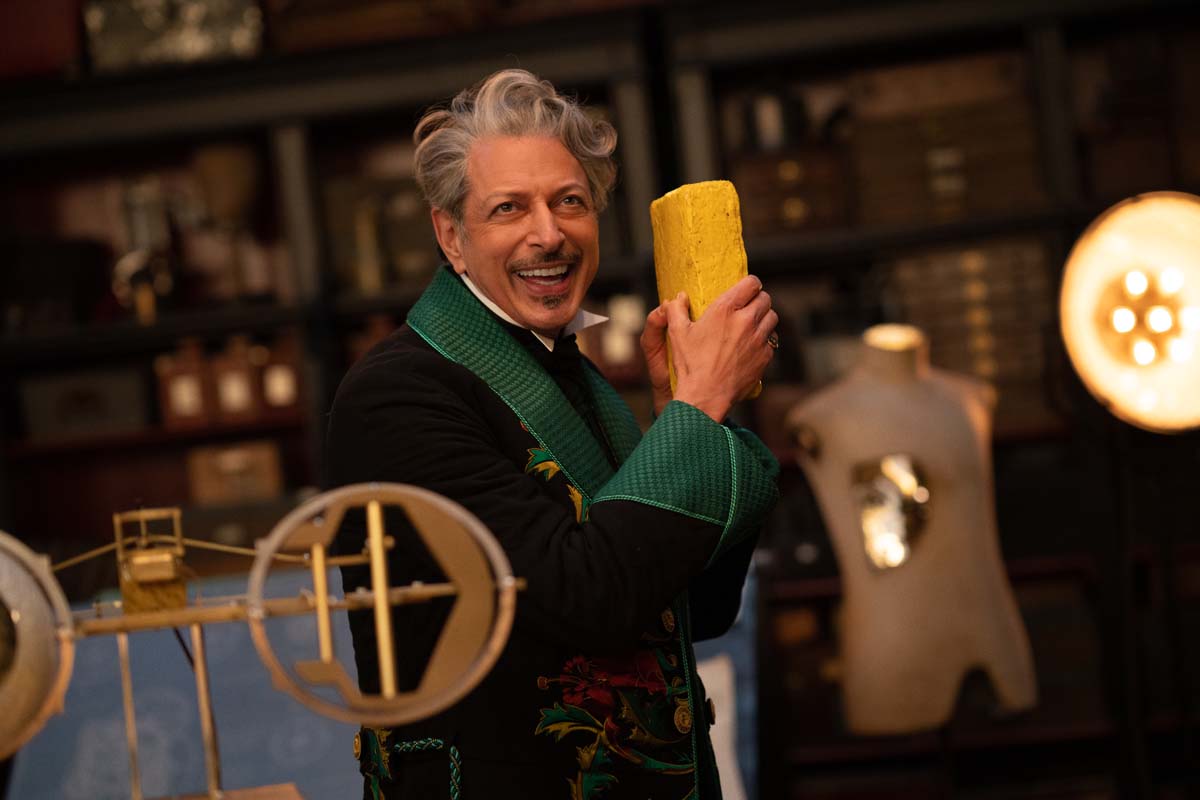
So you did have a big wall of cards…
Oh, yeah. 100%
Color coded?
They were frames from the film. The only thing that we did was that if it was a musical number, we had a bold green strip, that way I knew when the musical number is coming up. We magnetize all the cars, so when we do any restructuring, we can just flip them around.
Then Jon has Post-its all over it. When Jon first arrived in the room, everything looked so clean and beautiful, then, by the end, we’re ripping them in half and asking, “What if we intercut this scene and this scene?” It’s really helpful to have that visual representation in your edit room.

I wanted to talk about the editing of “Thank Goodness.” There’s a moment where Glinda’s feeling it, then she and Fiyero go away from the public eye for a moment, and when she comes back, she’s not really feeling it anymore, but she’s still singing it. Talk to me about how you supported that in editing.
I love “Thank Goodness.” What’s great about her performance is that it’s so vulnerable and so nuanced. When you come back to the scene – after they go around back, where it’s just stripped down and kind of awkward between these two characters - the last time you’ve really seen them together is they’re in love, and so much history is passed there.
Then when she comes back on stage, just feeling how awkward she feels now that she’s still supposed to be this, arm of the propaganda machine.
When we first assembled that number, it was much more cutty – cutting to the munchkins and the dancers and we had every crane shot, every coverage that you could imagine. We shot that for days.
But what we found is that the more intimate we made that moment, the more nuanced and brave the performance became. We also did this really clever thing at the very last moment where we have all this glitter slowed down in back of her.
That was literally a last minute thing that we tried. Jon said, “I have a feeling we could do one more thing…” But I said, “This is like a hat on a hat!” but it ended up working out that it supported it just enough to make it more magical and more brave in a way.
What I like about working with Jon in general is that we often have all the spectacle and these set pieces and we can do these action sequences and these big moments like “No Good Deed,” but then we could just make it almost sort of brave. I love that we could do that in the Ozdust Ballroom, or we could do that in “For Good.”
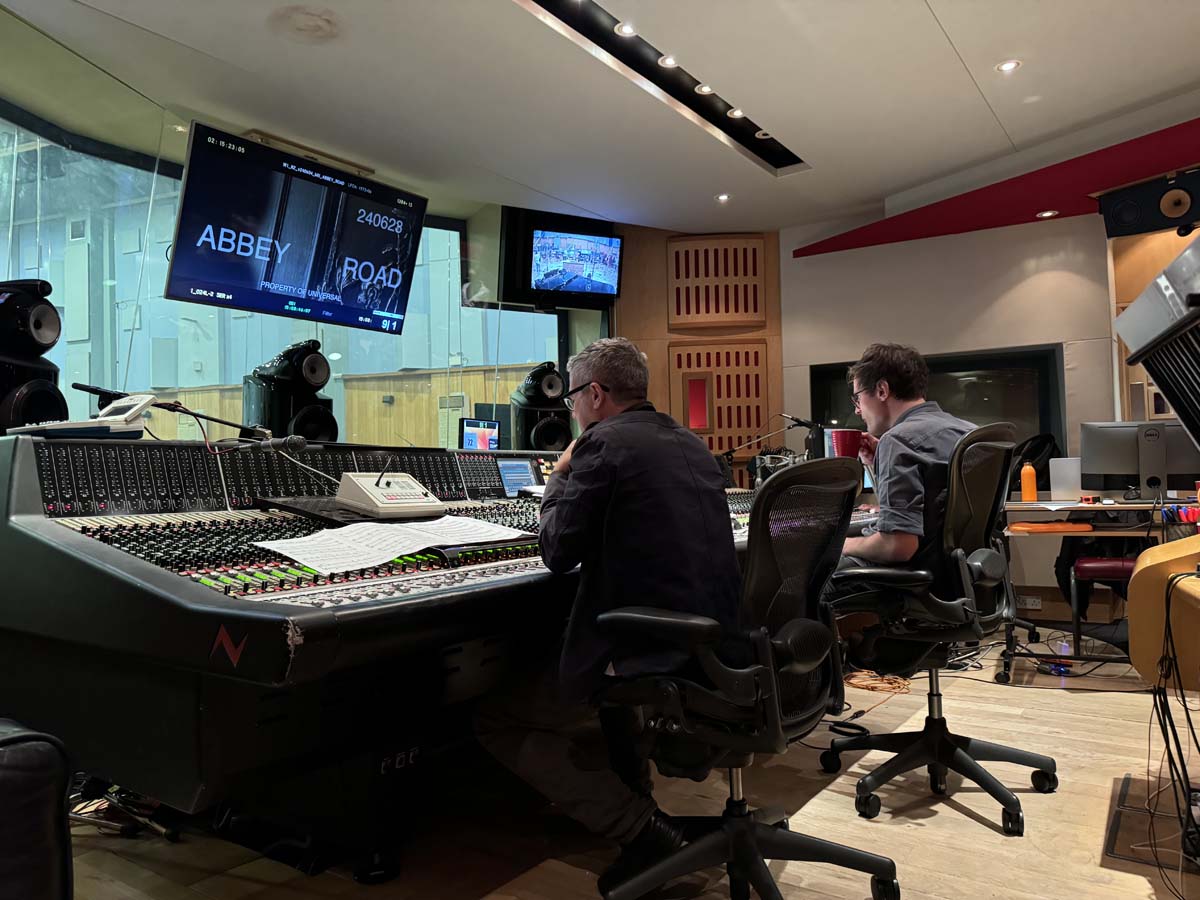
In, “Thank Goodness” when she’s singing, we’re just on her face. There are only a handful of cuts in, really to help just support a little bit. Just reminding us where she is, but not getting away from the performance. Just letting it drive and just making it feel really stripped down and raw.
Do you support the idea that I’ve heard from multiple editors that the audience senses that the less you cut the more true it feels?
No. I feel it just depends on what the subject matter is and what you’re presenting. For me, the harder scenes are the scenes that you cut less because it feels like you’re playing a classical guitar, so you can’t hide behind the action or the cuts between a lot of different kinds of footage.
So when you’re cutting something like the Ozdust Ballroom or “Thank goodness” or “For Good,” any false note, they’re going to hear it.
I learned that from like cutting the mahjong scene in Crazy Rich Asians. If I get this wrong, it’s all going to fall apart. It’s like dominoes. I don’t think there’s a larger truth that comes out of less cutting.
I do think that what I am trying to explore with my own editing is the power of a single cut, and whether or not I can truly convey emotion through one edit.
There are these incredibly big, grand films that are spectacles like Lawrence of Arabia. Anne Coates cutting that famous match shot to the dunes!
Could I ever, ever make an edit that good in my lifetime? What I love is the challenge of that: that you could get goosebumps from a single edit?
At the end of Wicked, I tried it. I tried to cut from one shot to the other and evoke emotion. So that’s the thing I’m chasing.
Not so much how many cuts are in the scene, but when I see a movie and I see the power of two images come together and I’m thinking, “Oh my goodness! Why am I crying from these two disparate images being placed next to one another?” So that’s the thing I’m chasing.
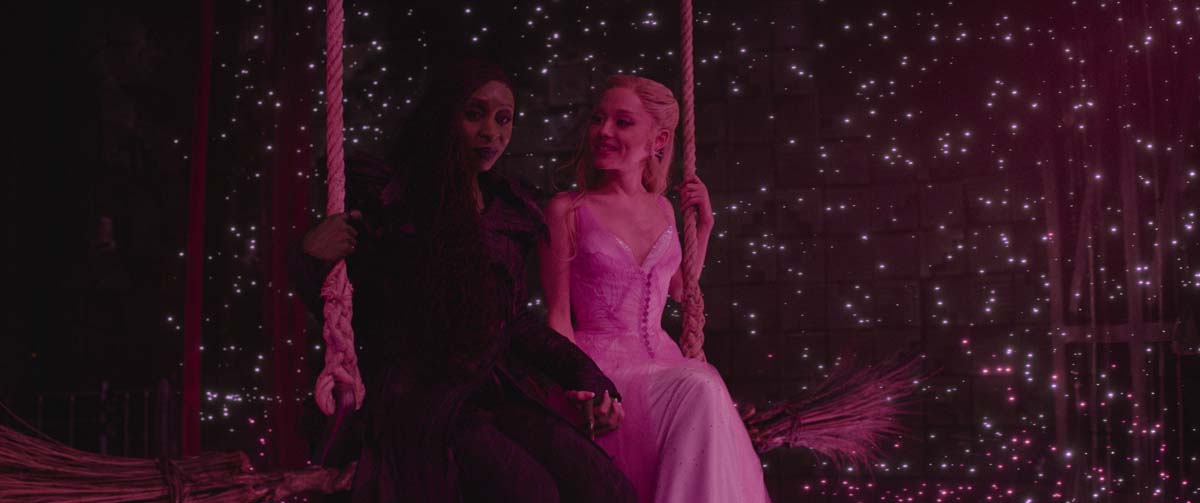
Like A Star is Born and the first Wicked movie, the vocals are being recorded live during the shoot, correct? Tell us about the difficulty of that and how that affected your editing.
Simon Hayes, our production mixer, was able to record all the singing - no different than dialogue - pristine and wonderful and I can use it all. That’s a feat in itself.
Simon Hayes - who worked on Le Mis and a host of other great films - he’s just perfected the art form of capturing these vocals. So already I’m starting from a place where I have these pristine recordings, then I can just treat it no differently from dialogue.
I’ll look at a scene - whether it’s dialogue or dialogue into music - that it’s just performance, so: “How am I reacting to something? Am I feeling something? Am I crying watching the dailies of ‘For Good?’
Where am I getting goosebumps?” I’m just chasing how a scene works dramatically and not worrying so much about whether or not it’s spoken or sung. Having said that, it is very complicated. It’s extremely complicated because I also have to be in rhythm.
A lot of times Cynthia and Ari would be singing off of a click track and sometimes they would be singing leading a piano. The piano wouldn’t lead them. The piano was live and basically following their lead, so it was like jazz, so I had to make sure that that all made sense musically.
I could go to Jack Damon and Catherine Wilson, my music editors, to ask, “Does this work musically? Can I start and stop the song like six times then have a dialogue scene?”
So that could be really, overwhelming - those aspects technically, where you’re sometimes off the musical grid. You’re sort of flying blind and creating the rhythms yourself.
But at the end of the day, I’m just trying to forget all that and trying to feel like, “What is this scene about?” And making sure that if they’re singing “For Good” and there’s dialogue in between, the scene doesn’t start and stop. It needs to be all one unit.

Myron on the mix stage
You’re also listening to a performance that’s different in every take. Usually in a musical it’s prerecorded, so every single take is exactly the same - maybe visually different - but you’re dealing with audio differences between every take.
Yeah, absolutely. I have the added pressure of comping Ariana Grande’s performance! I’m telling Ariana Grande, “This is the performance that I’ve cut for you.” The good thing is I had some practice at this, having worked on In the Heights and tick tick Boom. I had much more confidence having done those films.
Did you have to cut down any songs? We talked about this in our last interview that you said, “No, we actually added to the songs.” What happened on this film, and how hard is it to cut down a song or add to a song?
“Every Day More Wicked” - the opening song - was a song which definitely was like an accordion. We were adding or subtracting quite a bit. It’s very difficult to be able to do that without it feeling like we’re pulling the ripcord.
There were a bunch of flashbacks between Elphaba and Glinda singing “Defying Gravity.” In the middle of the song I tried some stuff in the opening of the film, but in the middle of the song they were singing “Defying Gravity” in the attic, and we just felt like it wasn’t really needed to see them together in that way. We wanted to use the flashbacks sparingly.

Stephen Schwartz and the music department have written songs very efficiently, then when you try to rip it out you have the problem of, “Okay, how do we put Humpty Dumpty back together again?”
“No Place Like Home” which was one of our new songs, was a song where there was much more of Elphaba flying around before she landed into the forest.
It was a bit of a reprise of “Defying Gravity” before she started into “No Place Like Home,” which we cut out and again, we just felt like there was some efficiency in the way that we could construct that.
That being said, it was all great. It was just like, “What is going to fight for survival? Where do we get bored?” If we’re going to start this new song, we better find the exact right way to start it. Do we need a reprise to sort of build into that?” These were the questions we asked ourselves.
So much of what we do is the structuring of songs and adding little bits of scenes and inserting that and starting and stopping songs.
I know that the audience sometimes doesn’t want us to do that, so we just have to make sure that we hold them in dramatically, and that when we make a pause or break in a song, we have to make sure that it feels earned and that, if we’re going to pull the ripcord out on the audience, that it doesn’t feel like we’re cheating and that they’re still involved dramatically.

Is that stuff that you felt you needed to explore in the screenings that you did?
Oh, 100%! We screened a lot for friends and family to figure this out and certainly in smaller screenings in our edit room. Then we started stepping out into bigger screenings. They would screen at Universal. By the time we got to our preview in Arizona, we had our act together.
I’ll be honest with you, there were moments where I was terrified because we were trying so many different ideas, and we wanted to make sure that everything that we experiment with was earned.
Sometimes those experiments failed miserably, but we had to test it on the audience and make sure that - if we were going to cut out a scene or a part of a scene - that we’ve always tried it with an audience before we’d cut it.
What were some of the things that you learned from those screenings?
We learned a lot about tone. We learned a lot about having a little bit more delight and worldbuilding and action and focusing on Glinda before we went to Boq and Nessa. That took a long time to figure out. We tested a lot of different versions in front of an audience.
The second half of the film - once we get the girls back together again - was a little bit more surefooted, but the first act we just really had to tinker and experiment quite a bit. Also, with “Girl in the Bubble” - our second new song in the film - we tinkered quite a bit about where that scene should go structurally as well.
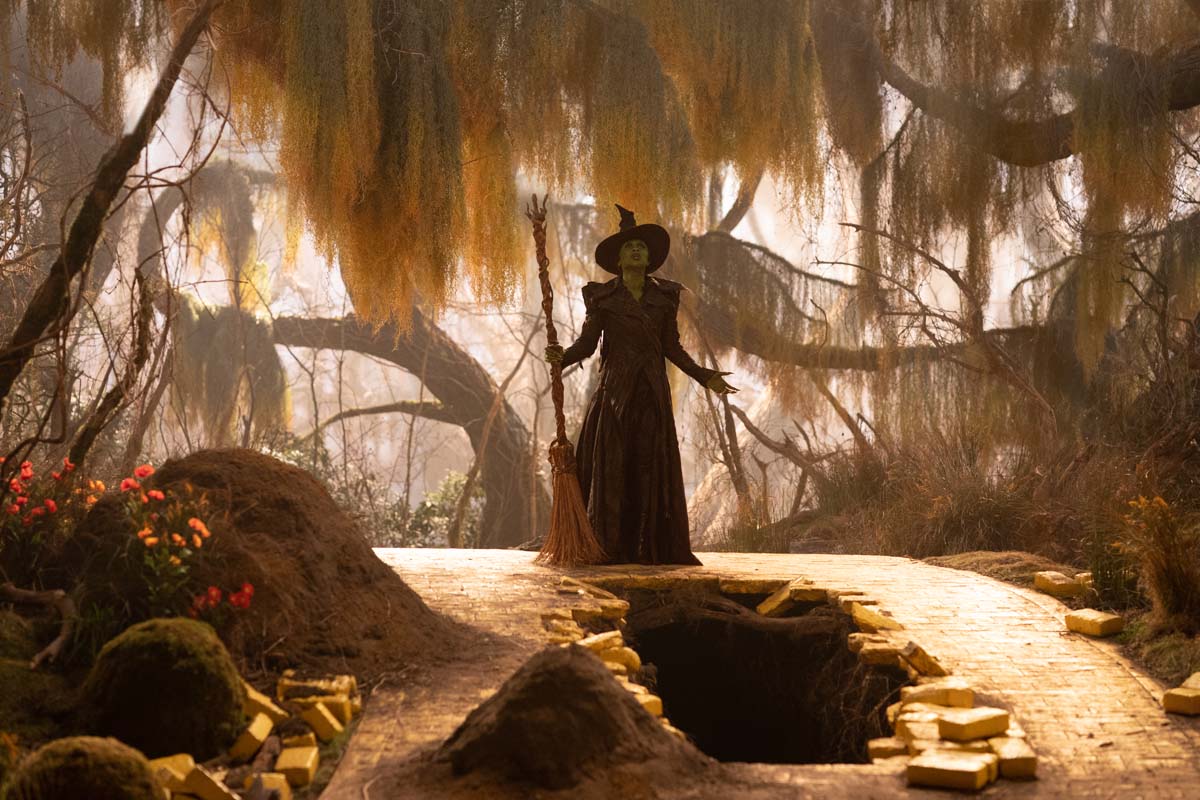
[Producer] Marc Platt had mentioned the possibility of moving it, but we didn’t know how. Finally, I suggested moving it a scene earlier, then we had these big outros and intros of the song that I had suggested that we just cut out and that would just bring us into silence.
All those things we were doing up to the last minute, but then we would then put it up in front of the audience and we’d see we still had the audience. We hadn’t lost them.The ending was massively difficult to figure out how to land that plane.
We knew that the movie really finishes with “For Good.” The moment where both of them say goodbye to each other, and there’s emotional weight to that musical number and scene.
When they’re on each side of that closet door, it’s painfully obvious how much they love each other and that we have the audience there with us.
But then we’re going to ask them to continue the emotion all the way to the end of the film, which is another 10-15 minutes. So, trying to have that feeling all the way through to the very end took so much experimentation. We just broke that thing apart in so many different ways.
There used to be a huge scene featuring Fiyero and Elphaba talking about why they couldn’t stay in Oz. We stripped that down and used a piece of dialogue as voiceover instead.
We experimented with tone of temp score to bin inform [composer] John Powell about how can we make this feel more hopeful and optimistic?
What shot do we end this film on? That was not the shot we’re going to end on. It was not scripted that way, so experimenting with all the different pieces of what the ending would be took a lot of being brave, then presenting it to an audience, then failing miserably, then trying again.
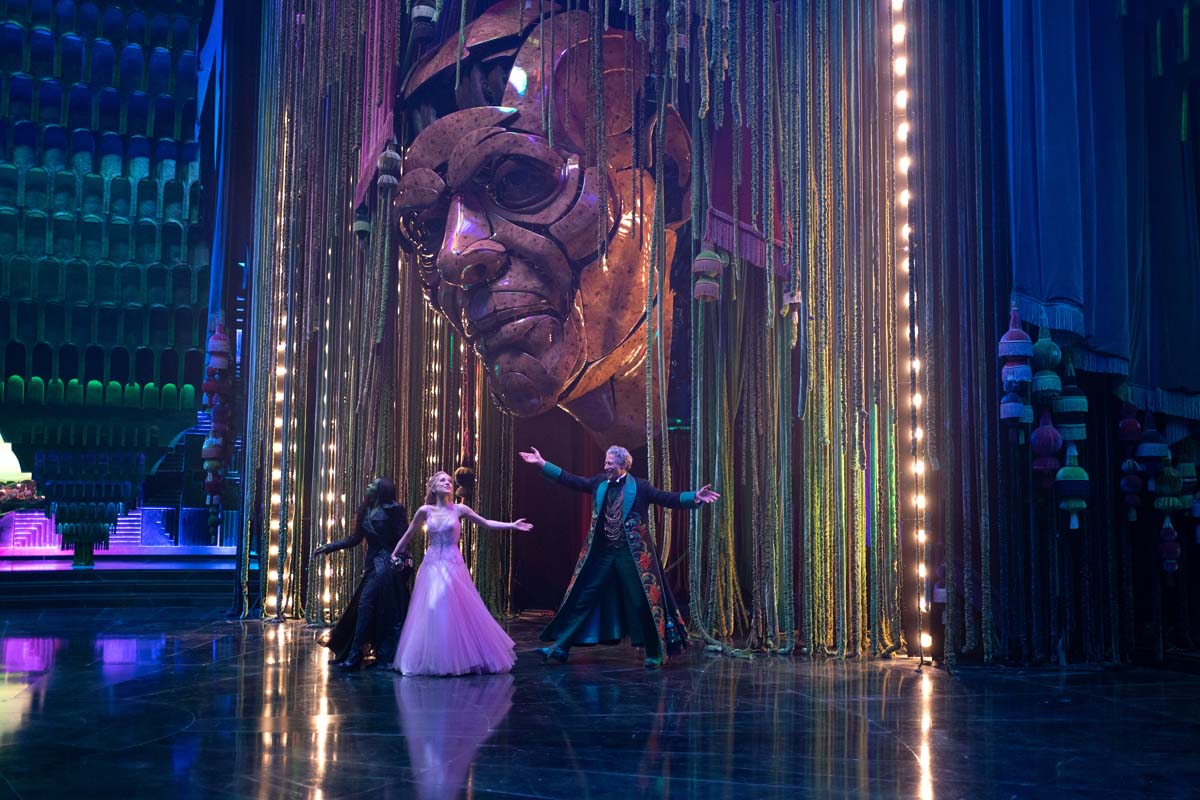
I wanted to talk about the transformation of the Tin Man scene. That was a complicated edit, I’m sure.
Yeah. There was a lot of experimentation about how much should we reveal of the Tin Man transformation. We shot a lot of elements that could make it like the transformation in The American Werewolf in London, but we decided that just because we can do it doesn’t mean we should. ILM and Framestore are two of the best VFX vendors in the world.
They can do anything we want! But just because we can doesn’t mean we should. I think there’s some power in that. We restrained ourselves from showing too much and we could create more tension by intercutting Nessarose and Elphaba conjuring and Boq transforming, then build up to this sort of monstrous reveal. That seemed to have more impact - rather than going all in on this moment.
Plus, we had done that type of transformation in the first film with Chistery (the monkey getting wings) - where we did see it, so to dip into that well again didn’t serve the tone.
And, I think the melodrama is to be intercutting that way, and to show this monstrous reveal just feels so much more delightful and meaty to me.
We’re presenting this iconic moment, where you’re seeing the Tin Man for the first time when he’s filled with so much anger and we’re seeing the Tin Man for the first time in a way that we’ve never seen him – he’s gone full incel - and practically murder Nessarose. How is he going to deal with this anger and this monstrous new version of himself?
“Hold off on showing the shark,” as Steven Spielberg would say.
Yes. And I used that analogy quite a bit over the course of making “For Good” where the girls are coming back together, but the more we hold them back - even though we’re yearning for them to be together - the more powerful it is when they are together when they’re ripped apart.
So we had to trust that in a certain way - even though either one of them weren’t present in some ways - even intercutting the two scenes of them during the wedding together had a certain amount of power of them sort of existing together without being in the same scene and elevated each of those scenes and to place a bit of darkness on Glinda, even though we want that wish fulfillment and how painful it felt for Elphaba if those scenes hadn’t been intercut together - which wasn’t scripted that way - than it would have felt a lot different.
How were they cut originally? One was in front of the other, obviously.
Yeah, it was Glinda first, then we went to Elphaba. By the way, they both worked as seperate, great scenes. Jon and I love cutting wedding scenes, and we knew it was going to be beautiful, and we really did love the idea of the wish fulfillment for Glinda.
I’ll just add that Tatiana Riegel ended up working a lot on that scene. Also Drew Buckland came on for a number of weeks, helping us find our way, so it was a big team effort trying to figure out how this all work together.
It took Framestore and ILM to bring all these animals and butterflies to life. That just took forever to get right. We wanted this big stampede – Day of the Locust, Titanic - moment when it all goes to crap, so treating it sort of delightful and also tension-filled was something that was found over the course of the edit.

While we’re talking about the wedding, talk to me a little bit about the lead-up to the wedding. There’s a really nice editing moment in there as the wedding is being prepared.
That was another team effort moment where we had a lot of disparate images together, between Glinda preparing and we didn’t have anything else other than the wizard standing at a console and this cool zoetrope shot, then, of course, Elphaba flying. So we actually started intercutting and playing with that, then adding Morrible’s voiceover.
There was also a scene between Fiyero and Glinda, where he shows up after she gets dressed for the wedding, and we felt like it was odd for him to show up right before the wedding, and he almost looks like he’s in love with Glinda, and we knew if couldn’t work that way. We have to strip this down.
And we ended up intercutting and adding Morrible’s voiceover. We ended up even stealing a moment of Morrible from the first movie and applying it there.
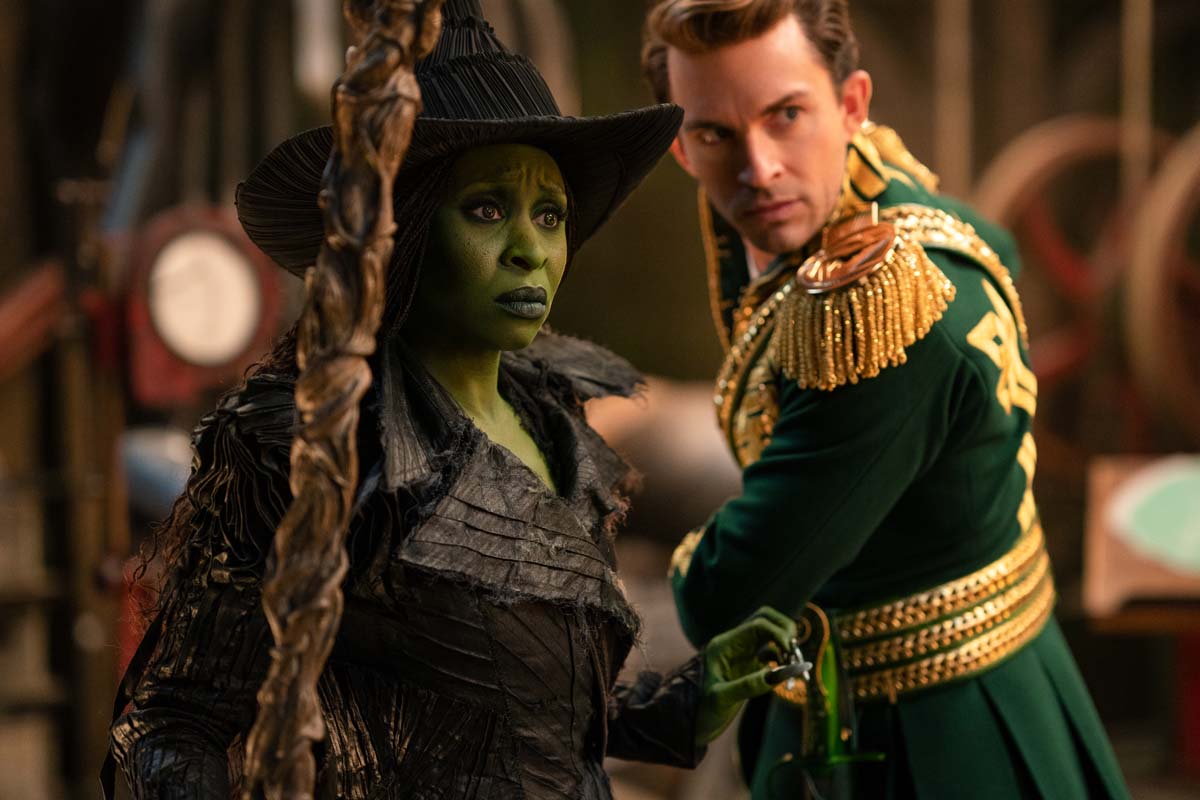
I wanted to talk to you about building songs to a climax emotionally. For example, the “For Good” song near the end.
Cutting “For Good” was no different than cutting the Ozdust Ballroom. This is the climax! And if “For Good” doesn’t work, then our film doesn’t work. The way that the audience has to connect to it emotionally and that they have to believe that these two characters are actually saying goodbye to one another - that there are stakes there. So, I was trying to slow down the scene and really start to “tap the pedal” on the pace of it and draw things out.
For me, I just love when two incredible actors - two movie stars - are looking at each other and longing for each other. This feels like a breakup scene, and not being afraid of stretching it until it breaks. Even with the music starting and stopping - these sort of acapella moments - not being afraid to stretch and find the performance is a little messy and nuanced. We found this little moment when Glinda does this little nose thing.
It’s just like a cute little thing that Ari did that just feels so human and just leaning into the performance and the looks and tempting the audience to want more. They don’t want to say goodbye to them! When they’re singing, it’s real tears!
In our first cuts of that scene we had these crane shots and we could use them to make it feel very dramatic and epic, but we found ourselves just wanting to be more and more intimate and not being afraid to be intimate in this big spectacle, even though you want your last song to feel epic. But we just said, “No, no, no! It’s about the girls, stupid.”
It’s about the two of them and the relationship. So to draw that out and to lean into that performance, then when they get to the closet, it’s actually cut very quickly. It’s so fleeting. They have seconds before they say goodbye. That in-camera split screen of them being on each side of the door and feeling the power and the melodrama and the operatic feel of that. One person used the word “diabolical.”
We have March on the Witch Hunters, and we have the mob pressing down on them, and we have the abduction of Dorothy, and we have, Glinda galloping to the castle. Then we just slow the song down and aren’t afraid of being intimate in the middle of an otherwise gigantic blockbuster.
I just love that Jon and I are willing to take big swings like that in the movies that we make together and that we can have a pin-drop moment where it’s just about these two looking at each other and that longing and not be afraid of it.
I’m assuming that there was no coverage for the kind of shadow-puppet scene right after that? Or was there?
We did have coverage. Most of it was shot from Glinda’s point of view. There are moments where Dorothy was doing a celebration dance, but we thought, “That’s a little too far.” We just chose to treat it more lyrically and more operatic.
That moment was set up at the beginning of the first film where we’re going to see a crime scene, and then to get to that moment, and present it in that way - all through Glinda’s point of view - and how devastating it is for her to see the melting of her friend.
What’s so wonderful about “For Good” is that we’ve done the work so that them saying goodbye actually feels real, and that the artifice has gone away and you feel very involved emotionally.
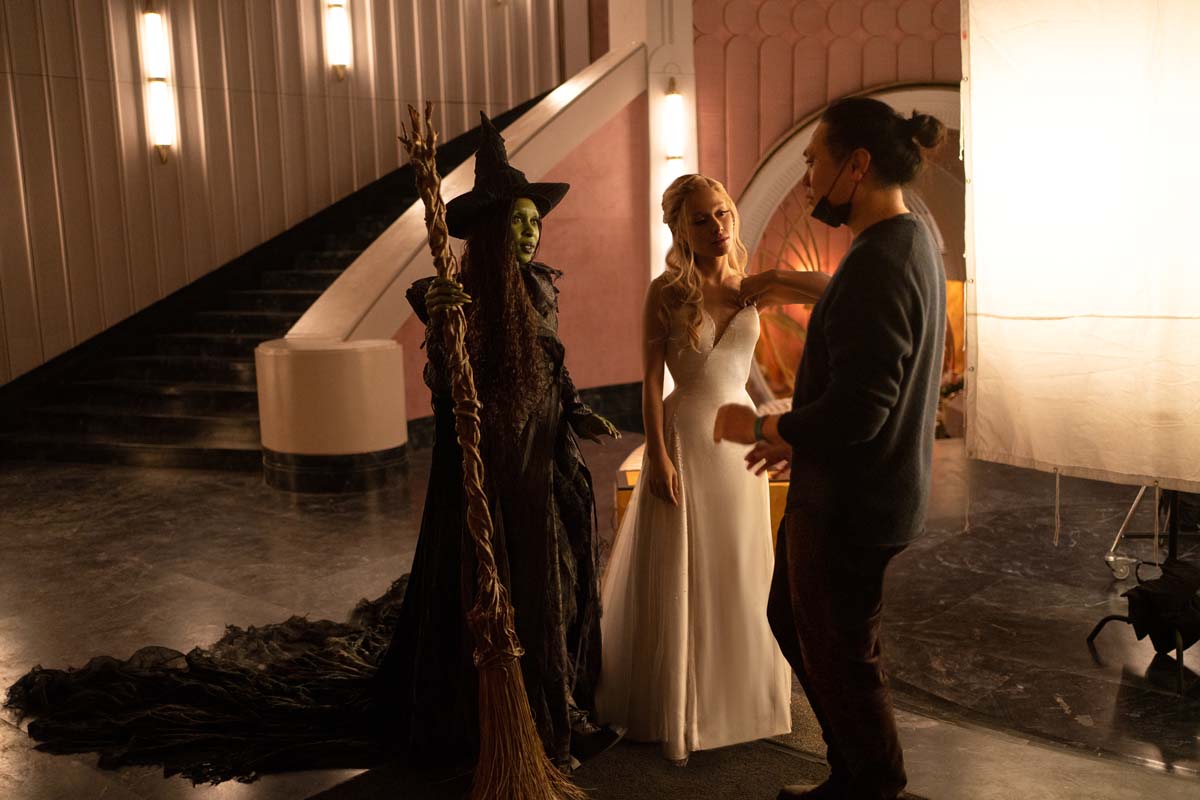
Anything that you would like to talk about specifically that was maybe either challenging or incredibly rewarding: a scene or a sequence or maybe it’s just the whole film.
I definitely feel like the whole film was quite a challenge just because it was so different from the first one. The success of the first one terrified me because I didn’t know if we could do it again, and I didn’t know if I had the bandwidth - or frankly, the talent - to pull it off. It just felt so different. What I’m most proud about is not giving up and just keeping at it.
There are so many things, like Morrible conjuring the cyclone, where I’m working with my VFX editor, figuring out those shots, then presenting to Jon that I’m happy about.
There’s so many things like “No Good Deed,” which is arguably – next to “Defying Gravity” - the biggest number, and I’m telling it through buiding a monkey army.
That is extremely complicated as an editor to pull off. But at the end of the day, it’s about tackling the tone and making sure that it feels earned and emotional and that I could land the plane so the fans don’t feel cheated.
The stakes were so much higher for me than working on Crazy Rich Asians or In the Heights, which had plenty of fans of the source material. But so many people love Wicked, and it means so much to so many people, and it wasn’t always a sure thing.
S o to not give up, to just keep tackling tone, to keep things feeling grounded and emotional amongst something that feels very epic, and the world-building is huge.
And to deliver something that I feel is powerful and again, to focus on that single edit and to try my best to convey something that’s going to make me cry and go back to the cinema.
Myron, thanks for talking to Art of the Cut. We really appreciate your work on this film.
Thank you, Stephen. Always a pleasure. Thank you for having me.
